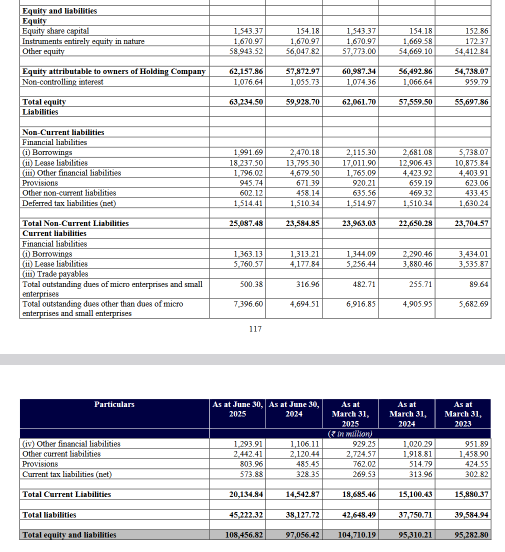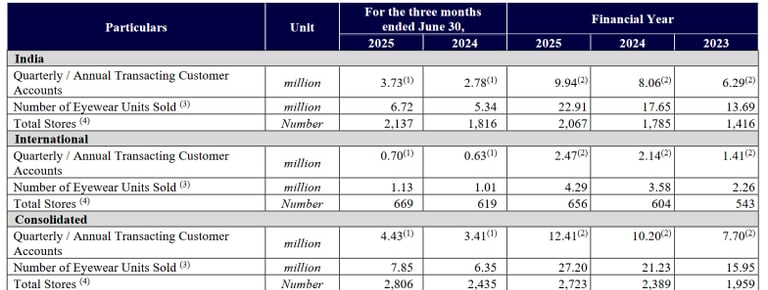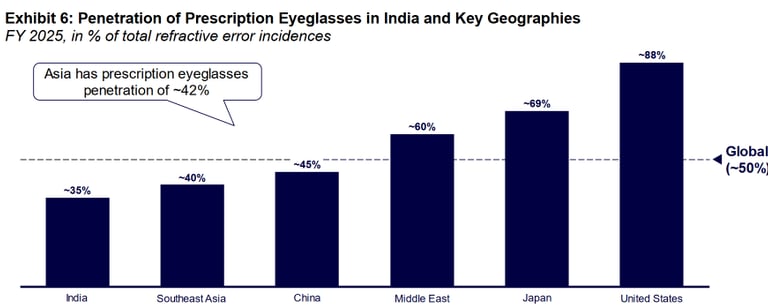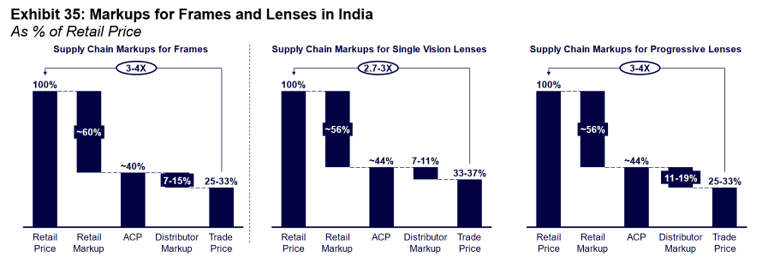Lenskart IPO Analysis
Operating metrics
Same store sales growth is 15.7% for FY25.
Eyewear units sold in FY25 is ~7.85 crore (India + International combined)
Average store sales is Rs 23,492/sq.ft/year (highest in India’s eyewear retail), value for Titan Eye plus is Rs 4600/sqft.
2 year purchase frequency is 3.62 eyeglasses per customer vs. national average of 1.8
Gross margin for FY25 is 67.9%.
Employee count as on FY25 is 17,607, with a tech team of 491 members.
Marketing expenses stand at 6.7% of revenues. Capacity utilization is at 55%
Bifurcation of sales (according to channels)
Stores 80%
Own website/app 11.5%
Other online channels 8.5%
Contents
Business
Industry overview
Operating metrics
Financials
Points to consider
IPO Size/ Promoter holding/ Market cap
Purpose of IPO
Valuation
Business
Lenskart is a technology-driven eyewear company with integrated operations spanning designing, manufacturing, branding and retailing of eyewear products , promoted by Peyush Bansal ,incorporated in 2008 as Valyoo Technologies Pvt. Ltd, later renamed as Lenskart in 2010. Their primary products are prescription eyeglasses, sunglasses, and other products such as contact lenses and eyewear accessories. Lenskart is the largest seller of prescription eyeglasses in India in terms of volumes. Brands owned are Owndays, John Jacobs, Vincent Chase, Lenskart Air, Hustlr and Hooper.
Lenskart has FY25 revenues of Rs 7010cr, with 60% revenues from India operations and 40% revenues from abroad. It operates from 2,137 stores in India and 669 stores abroad, totalling 2806 stores globally and ~1.73 mn sq.ft retail space. Out of 2137 stores, 1831 is own stores and 306 stores are franchisee owned. International stores are primarily located in Southeast Asia, Japan, and the Middle East.
2 year revenue CAGR of Lenskart is 33.5%.
More than 80% of their revenues is generated from prescription eyeglasses.
Lenskart is the only eyewear company in India providing next-day delivery at scale across 58 cities for single vision prescription eyeglasses
They own and operate frame and lens design and prescription eyeglasses manufacturing facilities at two locations in India in Bhiwadi, Rajasthan and Gurugram, Haryana, supplemented by regional facilities in Singapore and the United Arab Emirates. This centralized manufacturing and controlled supply chain in India has allowed them to deliver quality prescription eyeglasses at affordable costs and enable next day delivery at select locations. They acquired Owndays, a Japan and Southeast Asia-based eyewear brand in August 2022.
Lenskart offers complementary eye tests across all stores. To address the problem of low density of optometrists, Lenskart employed 164 optometrists at two central locations in India in Kolkata and Gurugram, conducting remote eye tests for customers at 298 stores across India as well as in select international markets.
During FY25,Lenskart conducted 38.59 million virtual try-ons and 37.87 million face/frame size measurements for customers in India through their mobile applications. They offer a membership program called “Lenskart Gold” in India and select international markets for customers. Started in 2018,this program has 7.12 million members as of June 30, 2025.
Lenskart faces competition from Eyegear Optics India (branded as “Ben Franklin”), Gangar Opticians , GKB Opticals Limited, Lawrence and Mayo (India) , Reliance Vision Express, Specsmakers Opticians and Titan Eye Plus, few of which have pan-India presence.
Financials
Total FY25 revenues of 7010cr .( Revenue CAGR 2 years 33.5%).
Titan Eye Plus revenues 800cr for FY25, EBIT Margin 10.7%
PAT Rs 30 cr vs Rs 10 cr loss last year.
Net cash flow from operations 1230cr.
Capex for FY25 is 420cr.
EBITDA margin 20%. ROCE 13.8%
Comparable peers Titan Eyewear division.
Goodwill 1875cr out of total assets 10845cr.
Receivables 140cr. Payables 790cr.
Inventory 1160cr. Cash 1970cr.
Borrowings 340cr. Equity 6320cr. Lease liabilities 2400cr.
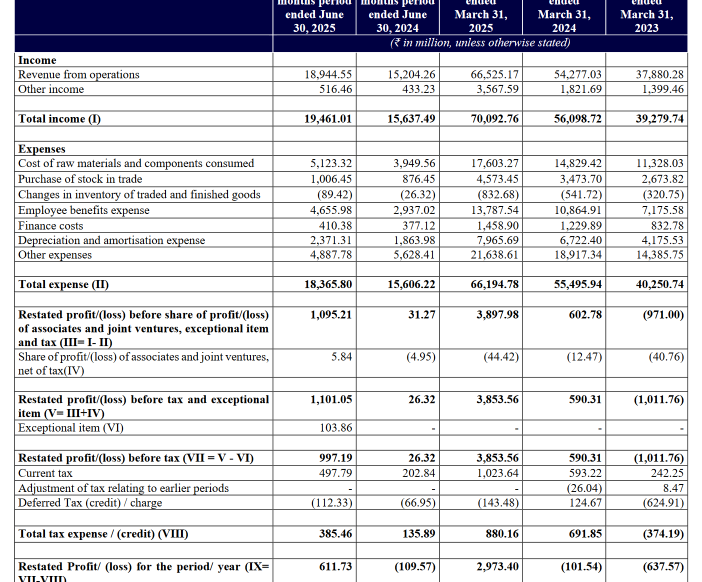

Points to consider
77% of Indian market remains unorganized, with intense price competition which is a risk.
There is an integration risk from multiple acquisitions (Owndays, Stellio, Dealskart)
Supply chain dependency on raw material vendors for lenses/frames is there, raw materials constitute 25% of revenues. Significant portion of raw materials is imported from China- any tariffs , policy change will become a risk factor.
Due to lack of pan-India organized players , it presents an opportunity before Lenskart to capitalize on that.
High incidences of refractive errors and low penetration of prescription eyeglasses at 35% presents a huge opportunity before organized players like Lenskart.
Rate of store closures have to be monitored. Out of 2806 stores in India, 111 stores were closed in FY25.
There is a technology risk where cost of LASIK surgeries goes down leading to affecting the prescription eyeglasses market for Lenskart.
IPO size /Promoter holding/ Market cap
Total offer 7280cr
Offer for Sale 5130cr
Fresh issue 2150cr
QIB- 75%
NII 15%
Retail 10%
Post listing promoter holding 17.5%
Price band- 382-402
Market cap post listing ~ 69730 cr
OFS sellers are SoftBank, Kedaara, Schroders, Alpha Wave, and the founding team
Purpose of IPO
Capital expenditure towards set-up of new CoCo stores in India 272cr
Expenditure for lease/rent/license agreements related payments for CoCo stores 591cr
Investing in technology and cloud infrastructure 213cr
Brand marketing and business promotion expenses 320cr
Valuation
Lenskart is valued at 285 P/E.
Follow us on twitter
You may be interested in
RR Kabel analysis
Hyundai Motors India analysis
Will Jio Financial disrupt Bajaj Finance
#themoatinvestor #dmoatinvestor #lenskart #listinggain


Industry overview
Indian eyewear market is valued at Rs 78,800 crore (FY25), expected to grow to Rs 1.48 lakh crore (US$17.2 bn) by FY2030 at CAGR ~8–9%.
Organized share is 23% (expected 31% by FY2030), leaving a huge scope of growth.
According to the “World Report on Vision” by the WHO published in October 2019, ~2.6 billion individuals were estimated to be affected by myopia and ~1.8 billion individuals by presbyopia. As per WHO estimates, these figures are projected to grow to ~3.4 billion and ~2.1 billion for myopia and presbyopia respectively by CY 2030P. The incidence of refractive errors has increased to ~4.0 billion (~49% of total population) in FY 2025 and is further projected to increase to ~4.7 billion (~55% of total population) by FY 2030P.
Major Growth Drivers:
-Increasing screen time leading to higher incidence of vision problems
-Rising disposable incomes, fashion eyewear adoption
-Expansion of organized retail and digital adoption
-Growing demand for affordable vision care in tier 2–3 cities
Penetration of prescription eyeglasses
Developed markets such as Japan and the United States have higher prescription eyeglasses penetration rates at ~69% and ~88% of the refractive error incidences, respectively, as of FY 2025, driven by better awareness, accessibility and affordability. Meanwhile, India lags with a penetration of ~35% of total refractive error incidences.
Low penetration of optometrists
Number of optometrists penetration is 35-50 per million population in India which is low compared to US - 110 . Optical store density is also low. Number of optical stores in India is 60 per million population whereas in US it is 130.
Average selling price of prescription eyeglasses is Rs 2370 in India as on FY25, that of sunglasses is Rs 1417,that of contact lenses Rs 219.
